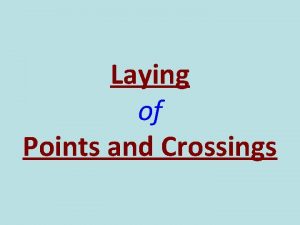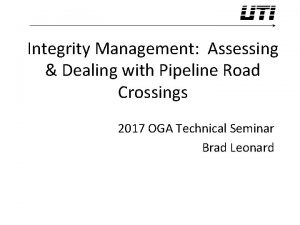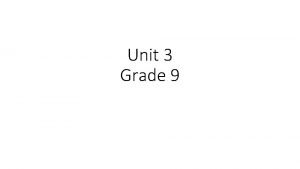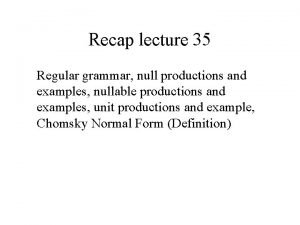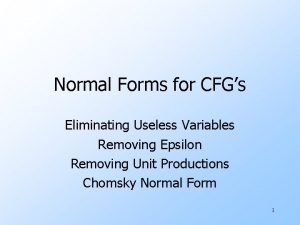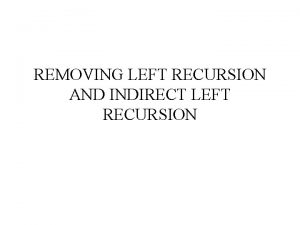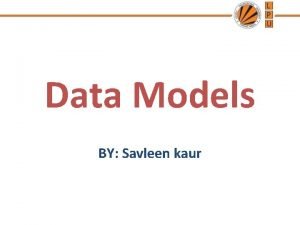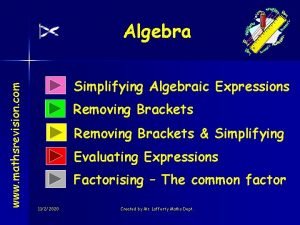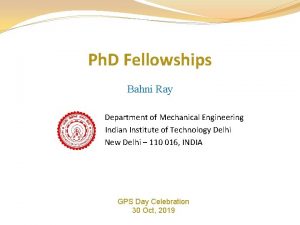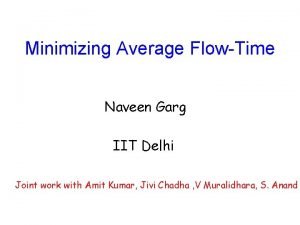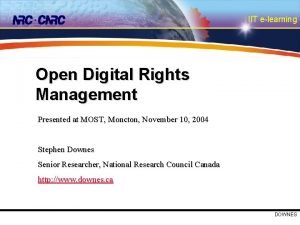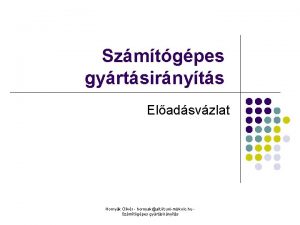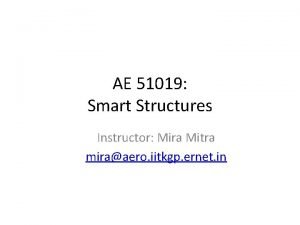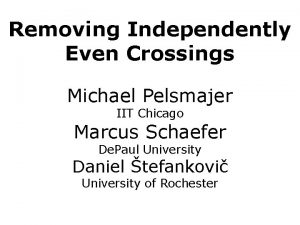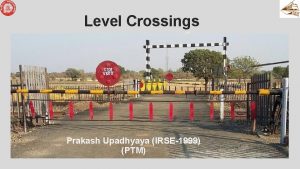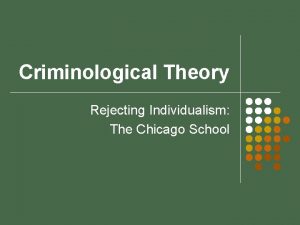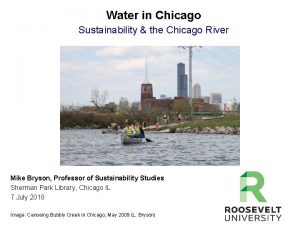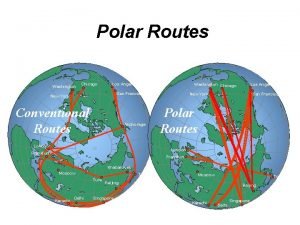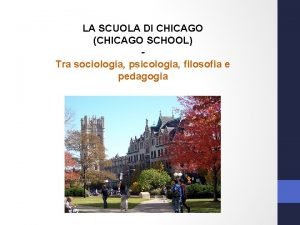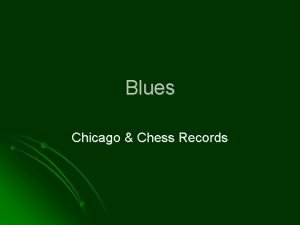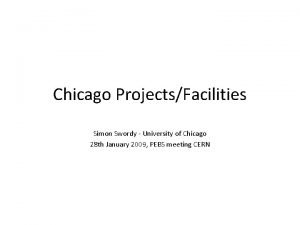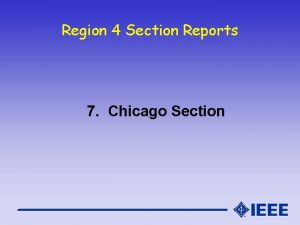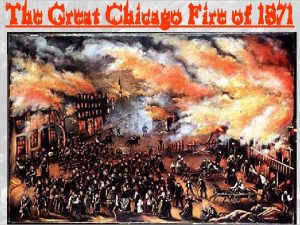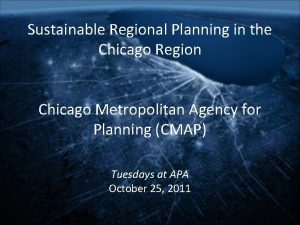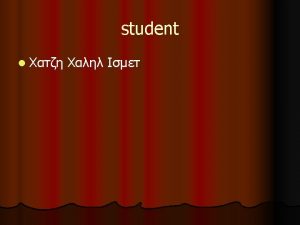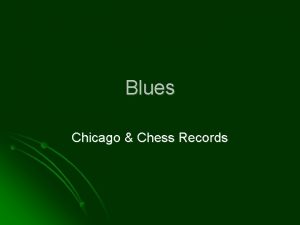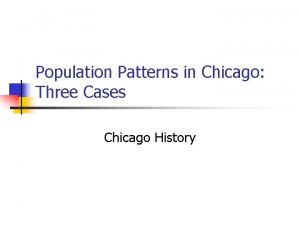Removing Independently Even Crossings Michael Pelsmajer IIT Chicago

































- Slides: 33

Removing Independently Even Crossings Michael Pelsmajer IIT Chicago Marcus Schaefer De. Paul University Daniel Štefankovič University of Rochester

Crossing number cr(G) = minimum number of crossings in a drawing* of G cr(K 5)=1 *(general position drawings, i. e. , no intersections with 3 edges, edges don’t cross vertices, edges do not touch)

Crossing number poorly understood, for example: ● don’t know cr(Kn), cr(Km, n) Guy’s conjecture: cr(Kn)= Zarankiewicz’s conjecture: cr(Km, n)= ● no approximation algorithm

Pair crossing number pcr(G) = minimum number of pairs of edges that cross in a drawing* of G pcr(K 5)=1 *(general position drawings, i. e. , no intersections with 3 edges, edges don’t cross vertices, edges do not touch)

Odd crossing number ocr(G) = minimum number of pairs of edges that cross oddly in a drawing* of G ocr(K 5)=1 oddly = odd number of times *(general position drawings, i. e. , no intersections with 3 edges, edges don’t cross vertices, edges do not touch)

Rectilinear crossing number rcr(G) = minimum number of crossings in a planar straight-line drawing of G rcr(K 5)=1

“Independent” crossing numbers only non-adjacent edges contribute iocr(G)=minimum number of pairs of non-adjacent edges that cross oddly in a drawing of G ocr(G) = minimum number of pairs of edges that cross oddly in a drawing of G

“Independent” crossing numbers only non-adjacent edges contribute iocr(G)=minimum number of pairs of non-adjacent edges that cross oddly in a drawing of G What should be the ordering of edges around v? v “independent’’ does not matter!

iocr(G)=CVP {e 0, e 1} any initial drawing (v, g) 1 0 if g=ei and v is an endpoint of e 1 -i otherwise columns = pair of non-adjacent edges, e. g. , for K 5, 15 columns rows = non-adjacent (vertex, edge), e. g. , for K 5, 30 rows

iocr(G)=CVP {e 0, e 1} any initial drawing (v, g) 1 0 if g=ei and v is an endpoint of e 1 -i otherwise columns = pair of non-adjacent edges, e. g. , for K 5, 15 columns rows = non-adjacent (vertex, edge), e. g. , for K 5, 30 rows

Crossing numbers iocr(G) acr(G) pcr(G) ocr 0 1 0 0 acr 0 1 0 2 cr(G) rcr(G) pcr 0 1 1 1 cr 0 1 2 2

Crossing numbers iocr(G) acr(G) ocr(G) – amazing fact pcr(G) rcr(G) iocr(G)=0 rcr(G)=0 iocr(G)=0 rcr(G)=0 (Hanani’ 34, Tutte’ 70) (Steinitz, Rademacher’ 34; Wagner ’ 36; Fary’ 48; Stein’ 51)

Crossing numbers iocr(G) acr(G) ocr(G) – amazing fact pcr(G) rcr(G) iocr(G) 2 rcr(G)=iocr(G) 2 cr(G)=iocr(G) (present paper) cr(G) 3 rcr(G)=cr(G) (Bienstock, Dean’ 93)

Crossing numbers - separation iocr(G) acr(G) ocr(G) pcr(G) Tóth’ 08 Pelsmajer, Schaefer, Štefankovič’ 05 different maybe equal? rcr(G) Guy’ 69 cr(K 8) =18, rcr(K 8)=19

Crossing numbers - separation BIG iocr(G) acr(G) ocr(G) pcr(G) very different maybe equal? rcr(G) Bienstock, Dean ’ 93 ( k 4)( G) cr(G)=4, rcr(G)=k

Crossing numbers - separation BIG iocr(G) acr(G) ocr(G) polynomially related very different maybe equal? rcr(G) Bienstock, Dean ’ 93 ( k 4)( G) cr(G)=4, rcr(G)=k Pach, Tóth’ 00 cr(G) (2 ocr(G) ) 2

Crossing numbers - separation BIG iocr(G) acr(G) ocr(G) polynomially related our result very different cr(G) different (2 iocr(G) ) 2 maybe equal? rcr(G) Bienstock, Dean ’ 93 ( k 4)( G) cr(G)=4, rcr(G)=k Pach, Tóth’ 00 cr(G) (2 ocr(G) ) 2

our result very different cr(G) different (2 iocr(G) ) 2 e is bad if f such that ● e, f independent ● e, f cross oddly drawing D realizing iocr(G) bad edges good edges |bad| 2 iocr(G)

drawing D realizing iocr(G) bad edges good edges |bad| 2 iocr(G) GOAL: drawing D’ such that • good edges are intersection free • pair of bad edges intersects 1 times

drawing D realizing iocr(G) bad edges good edges even edges |bad| 2 iocr(G) GOAL: drawing D’ such that • good edges are intersection free • pair of bad edges intersects 1 times

drawing D realizing iocr(G) bad edges Lemma (Pelsmajer, Schaefer, Stefankovic’ 07)good edges even edges cycle C consisting of even edges |bad| 2 iocr(G) redrawing so that C is intersection free, no new odd pairs, same rotation GOAL: drawing D’ such that system • good edges are intersection free • pair of bad edges intersects 1 times

good even, locally bad edges good edges even edges |bad| 2 iocr(G) cycle of good edges cycle of even edges intersection free cycle

good even, locally bad edges good edges even edges |bad| 2 iocr(G) cycle of good edges cycle of even edges intersection free cycle

good even, locally bad edges good edges even edges |bad| 2 iocr(G) cycle of good edges cycle of even edges intersection free cycle

good even, locally bad edges good edges even edges |bad| 2 iocr(G) cycle of good edges cycle of even edges intersection free cycle degree 3 vertices

good even, locally bad edges good edges even edges |bad| 2 iocr(G) cycle of good edges cycle of even edges intersection free cycle degree 3 vertices

good even, locally cycle of good edges cycle of even edges intersection free cycle degree 3 vertices repeat, repeat potentials decreasing: = dv 3 #good cycles with intersections DONE good edges in cycles are intersection free

DONE good edges in cycles are intersection free bad edges good edges not in a good cycle

look at the blue faces bad edges good edges not in a good cycle

add violet good edges, no new faces bad edges good edges not in a good cycle

add bad edges in their faces. . . bad edges good edges not in a good cycle

Open problems Is pcr(G)=cr(G) ? D A B C D A on annulus? B C

Open problems Is iocr(G)=ocr(G) ? (genus g strong Hannani-Tutte) Does iocrg(G)=0 ? Is cr(G)=O(iocr(G)) ?
 Contrary flexure in railway
Contrary flexure in railway Road crossing sleeve
Road crossing sleeve Controlled railroad crossings usually have
Controlled railroad crossings usually have An uncontrolled railroad crossing usually has a
An uncontrolled railroad crossing usually has a Chapter 7 negotiating intersections
Chapter 7 negotiating intersections Regular expression of even even language
Regular expression of even even language Recursive definition in automata
Recursive definition in automata Each packet is treated independently
Each packet is treated independently A switched wan is normally implemented as a network
A switched wan is normally implemented as a network Diversity the art of thinking independently together
Diversity the art of thinking independently together Verb 3 shorten
Verb 3 shorten What's the
What's the Provide room service
Provide room service Null production example
Null production example Basic hand tools and their uses
Basic hand tools and their uses The process of removing the radical sign in the denominator
The process of removing the radical sign in the denominator Elimination of parallax
Elimination of parallax Removal of epsilon productions
Removal of epsilon productions Immediate left recursion
Immediate left recursion Removing brackets example
Removing brackets example Removing barriers in the workplace
Removing barriers in the workplace Removing redundant attributes in entity sets
Removing redundant attributes in entity sets Who created algebra
Who created algebra Removing barriers to literacy
Removing barriers to literacy Bahni ray iit delhi
Bahni ray iit delhi Naveen garg iit delhi
Naveen garg iit delhi Iit general counsel
Iit general counsel Coa virtual lab iit kharagpur
Coa virtual lab iit kharagpur Pmv subbarao iit delhi
Pmv subbarao iit delhi Iit
Iit Cs 105 iit
Cs 105 iit Dr shweta agrawal
Dr shweta agrawal Hornyk
Hornyk Mira mitra iit kgp
Mira mitra iit kgp
